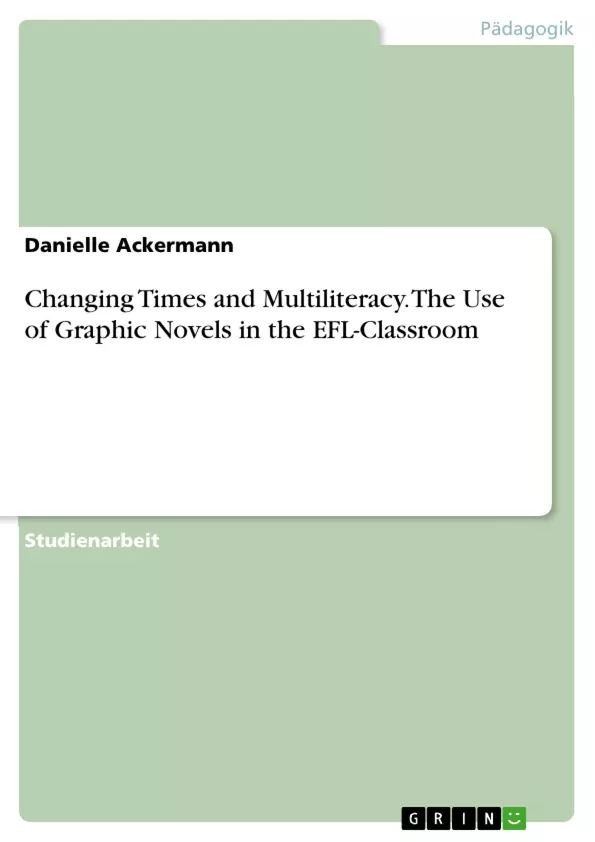Graphic novels, which are closely related to comics and manga/anime, are today a fast growing medium in the U.S. and a new focus in literacy and language education. There is already a broad variety of Graphic Novels and they enjoy great popularity. As Callahan (2009) puts it, this medium is „exciting, with variety, controversy, diversity and literary merit“. Moreover, the topics range from history and wars via politics to civil rights and also personal issues are picked out as central themes, which could serve as a great advantage in the EFL-Classroom.
Additionally, reading is one of the most important skills students need to acquire when they learn a language. Reading comprehension as information processing is a steady act of meaning construction. We are constantly confronted with various reading situations, for example, in every-day life, school, work, leisure or in self-education. Thinking of the question about what can be read, a multitude of reading situations might be enlisted. Here are just a few examples: one can read any kind of book, magazines, newspapers, manuals, subject specific and scientific literature, online-articles, medical instruction leaflets as well as letters and even any signs. Looking at those situations, there are three different functions of reading. First, one might read to get information, for instance, to find out about a specific person by using wikipedia. Second, reading because of psychological-emotional driven intentions, for example, reading a novel that one is interested in. And third, one might read to acquire a foreign language. Anyway, wouldn't it be great to combine at least two of those functions reading a novel in the EFL-Classroom?
Students always try to identify themselves with topics and they are self-motivated if they can deal with things they are interested in and that concern them, but at the same time they need to acquire various competencies in the EFL-Classroom. As Graphic Novels fulfil both criteria from my point of view, this paper wants to enlighten this medium more closely. Therefore, I would like to describe the history of Graphic Novels and the term itself first (chapter 2). The third chapter deals with changing times and changing literacies, followed by my fourth part that takes a closer look onto several advantages of using Graphic Novels in the EFL-Classroom. Finally, I would like to sum up the most important aspects in my conclusion.
Inhaltsverzeichnis
- Introduction
- The History and Definition of Comics and Graphic Novels.
- Changing Times and Multiliteracies for the EFL-Classroom….........
- Motivating learners to read with Graphic Novels ........
- Developing Critical Literacy with Graphic Novels
- Developing Multimodal Literacy with Graphic Novels.......
- Developing Functional Literacy with Graphic Novels
- Conclusion...........
Zielsetzung und Themenschwerpunkte
Diese Arbeit untersucht die Verwendung von Graphic Novels im Englisch als Fremdsprache-Unterricht (EFL). Sie zielt darauf ab, die Vorteile dieses Mediums aufzuzeigen und zu erklären, wie es die Motivation der Lernenden steigern, die kritische und multimodale Literacy fördern und die Entwicklung der funktionalen Literacy unterstützen kann.
- Die Geschichte und Definition von Comics und Graphic Novels
- Die Bedeutung von Multiliteracies im EFL-Unterricht
- Die Vorteile von Graphic Novels für die EFL-Lernenden
- Die Rolle von Graphic Novels in der Entwicklung verschiedener Literacy-Kompetenzen
- Die Bedeutung von Graphic Novels als Werkzeug für die Motivation und den Lernerfolg
Zusammenfassung der Kapitel
Das erste Kapitel führt in das Thema ein und stellt die Bedeutung von Graphic Novels im EFL-Unterricht dar. Kapitel zwei beleuchtet die Geschichte und Definition der Begriffe Comic und Graphic Novel, wobei die Entwicklung des Mediums von seinen Anfängen bis zur heutigen Bedeutung im Kontext von Literatur und Kunst dargestellt wird. Kapitel drei beschäftigt sich mit der Bedeutung von Multiliteracies im EFL-Unterricht und verdeutlicht die Notwendigkeit, den Unterricht an die sich verändernden Anforderungen der heutigen Zeit anzupassen. Die Vorteile der Verwendung von Graphic Novels im EFL-Unterricht werden im vierten Kapitel ausführlich diskutiert. Dieses Kapitel beleuchtet die Möglichkeiten von Graphic Novels, die Motivation der Lernenden zu steigern, die kritische und multimodale Literacy zu fördern und die Entwicklung der funktionalen Literacy zu unterstützen.
Schlüsselwörter
Graphic Novels, EFL-Unterricht, Multiliteracies, kritische Literacy, multimodale Literacy, funktionale Literacy, Motivation, Lernerfolg, Comics, Kunst, Literatur,
- Quote paper
- Danielle Ackermann (Author), 2011, Changing Times and Multiliteracy. The Use of Graphic Novels in the EFL-Classroom, Munich, GRIN Verlag, https://www.grin.com/document/336622



